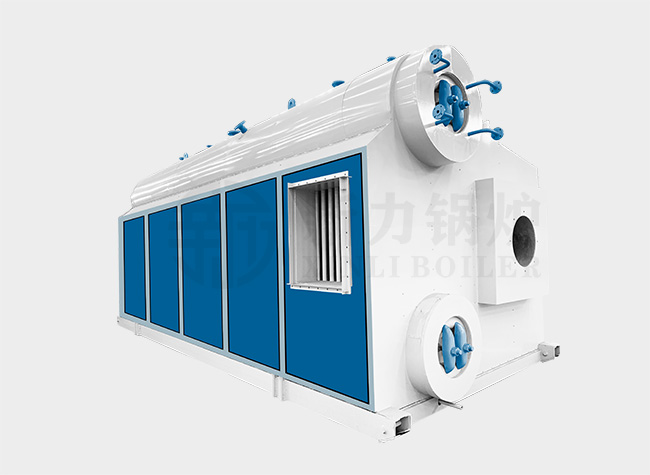Guide: The WNS oil-fired gas boiler adopts a horizontal three-pass wet back structure. The internal water of the boiler reports fire, the heating area is large, and the heat exchange effect is good. So, what is a wet back boiler and what are its characteristics? The steam boiler needs cleaning for long-term operation. What are the cleaning methods for the boiler?
The WNS oil-fired gas boiler adopts a horizontal three-pass wet back structure. The internal water of the boiler reports fire, the heating area is large, and the heat exchange effect is good. So, what is a wet back boiler and what are its characteristics? Steam boilers need cleaning for long-term operation. What are the boiler cleaning methods?
1. Wet back boiler
1. "Wet-back" boiler means that the boiler's flue gas chamber is moved into the barrel of the corresponding boiler model. The tube plate, back plate and cylinder of the flue gas chamber are all surrounded by boiler water (that is, immersed in boiler water). So it is called "wet back" (also called water back).
"Wet back" structure boiler advantages:
2. The advantages of "wet back" boilers:
After the flue gas enters the human smoke pipe (the first return smoke pipe) through the turning smoke chamber, the temperature of the smoke is already low when the front smoke box is reached (usually around 450°C), which makes the structure and manufacture of the front smoke box simple. Generally, a steel structure lined with thermal insulation material is sufficient.
The "wet back" structure can adapt to high temperatures, has good airtightness, and its volume is much smaller than that of the "dry back" smoking chamber. Therefore, the shortcomings of the "dry back" structure can be avoided, the normal operation period of the boiler can be extended, and the maintenance cost can be reduced, so it has been widely used.

2. Cleaning method of wet back steam boiler
1.Outside the pot water treatment-lime + soda ash softening method
This method is applicable to various boilers. At present, the effect of water treatment outside the pot is reliable. During boiler operation, avoid water shortage in the boiler. The lime + soda ash softening method is to add an appropriate amount of quicklime and soda ash to the clarified water to achieve the purpose. There are two softening methods of lime + soda ash: cold method and hot method. The cold treatment is performed at room temperature to reduce the residual hardness in the water to 1.5 to 2 meq/l. The thermal method is to heat the water to 20-80°C to reduce the residual hardness in the water to 0.3-0.4meq/L.
Therefore, thermal methods should be used as much as possible to improve the softening effect. The ion exchange softening method mainly relies on the softening treatment of the exchange resin in the sodium ion exchanger. Due to the strong adsorption capacity of the exchange resin, it can absorb the free calcium and magnesium ions in the water, so that the hardness of the boiler feed water reaches the qualified standard. There are two major types of ion exchangers, inorganic and organic. Inorganic exchange resins can only be used for surface exchange, with poor softening effect and less use. The organic exchange resin is characterized in that the core structure of the particles is loose, and the exchange reaction can be carried out on the surface and inside of the particles at the same time, and the softening effect is good, so it is used more.
2. Pot water treatment-adding chemical reagents
This method is mainly to add chemicals to the boiler water to form loose sediments. Calcium and magnesium salts form scale in the boiler water, and then discharge the sediments out of the furnace through sewage discharge, thereby preventing (or reducing) boiler fouling. The furnace chemical water treatment is generally used in small low-pressure fire tube boilers.
The commonly used drugs in pot water treatment are: trisodium phosphate, sodium carbonate (soda), sodium hydroxide (such as caustic soda, also known as caustic soda) and organic colloid (silica gel).
When adding medicines, various medicines should be prepared into solutions first, and then added to the pot. Generally, the solution concentration of trisodium phosphate is 5 to 8%, the solution concentration of sodium carbonate is not more than 5%, and the concentration of sodium hydroxide is not more than 1 to 2%. Both quantitative and continuous dosing can be used in the 1653 dosing method. The regular dosing mainly relies on the metering tank for dosing; the water is continuously added before the watering device. For steam boilers, it is better to use a continuous metering method to keep the liquid in the furnace uniform. Anyone who uses water treatment in the boiler should strengthen the boiler discharge, so that the formed sludge and mud can be discharged out of the furnace, and good results have been achieved.
The above introduced the cleaning methods of wet-back boilers and wet-back steam boilers. When using industrial boilers, pay attention to adopting scientific and reasonable operation methods, and regularly maintain the boilers and test the water quality to ensure the boiler’s operating effect and service life.




























